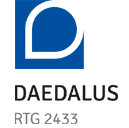
- This event has passed.
DAEDALUS online Winter School talk by Prof. Dr. Markus Bär
January 20, 2022 at 4:00 pm - 5:30 pm
Abstract: Many relevant experimental systems and applications exhibiting spatiotemporal dynamics and pattern formation in fluid dynamics and life science are well described by nonlinear differential equations such as the Navier-Stokes equation or reaction-diffusion models. A common occurrence are irregular high-dimensional dynamical states such as spatiotemporal chaos or turbulence. In this talk, I will present two examples of such behavior where it is desirable to control such states by transforming their dynamics into homogeneous or periodic steady states, oscillations or waves. In order to do so, it helps to understand the mechanisms behind such complex dynamics and/or to identify suitable states where external pertubations can provide efficient control. The specific applications are (i) defibrillation of cardiac tissue by periodic pacing and (ii) turbulence in active suspensions. For the cardiac system, we used simulations as well as data analysis not only to identify suitable conditions e. g. pacing strength and periods [1, 2], but also to determine the mechanism of defibrillation in this specific modus. For active turbulence, a simple phenomenological deterministic continuum model was developed and used for quantitative modelling of experimental in bacterial suspensions [3]. In later work, similar behavior was reproduced in a modified version of the celebrated Viscek model of self-propelled particles [4] and a continuum model of partial differential equations containing the simple phenomenological model as special case was derived from a stochastic model for the motion of individual swimmers [5, 6]. Detailed investigations of the model showed also how the turbulent collective dynamics could be transformed into more regular, periodic spatiotemporal patterns in line with recent experimental findings using confinement to produce vortex lattices instead of irregular, turbulent motion [7]. In the final part of the talk, potential applications of machine learning in both applications will be briefly discussed.
[1] P. Buran, M. Bär, S. Alonso and T. Niedermayer. Control of electrical turbulence by periodic excitation of cardiac tissue. Chaos 27, 113110 (2017).
[2] P Buran, T Niedermayer, and M Bär. Suppression of fibrillation consisting of stable rotors by periodic pacing. https://www.biorxiv.org/content/10.1101/2021.08.25.457679v1.abstract (2021).
[3] J. Dunkel, S. Heidenreich, K. Drescher, H. H. Wensink, M. Bär and R. E. Goldstein. Fluid dynamics of bacterial turbulence. Phys. Rev. Lett. 110, 228102 (2013).
[4] R. Großmann, P. Romanczuk, M. Bär and L. Schimansky-Geier. Vortex arrays and mesoscale turbulence of self-propelled particles. Phys. Rev. Lett. 113, 258104 (2014).
[5] S. Heidenreich, J. Dunkel, H. Klapp and M. Bär. Hydrodynamic length-scale selection in microswimmer suspensions. Phys. Rev. E,94, 020601 (2016).
[6] H. Reinken, S. H. L. Klapp, M. Bär and S. Heidenreich. Derivation of a hydrodynamic theory for mesoscale dynamics in microswimmer suspensions. Phys. Rev. E 97, 022613 (2018).
[7] H. Reinken, D. Nishiguchi, S. Heidenreich, A. Sokolov, M. Bär, S. H. L. Klapp, and I. Aranson. Organizing bacterial vortex lattices by periodic obstacle arrays. Comm. Phys. 3, 76 (2020).
